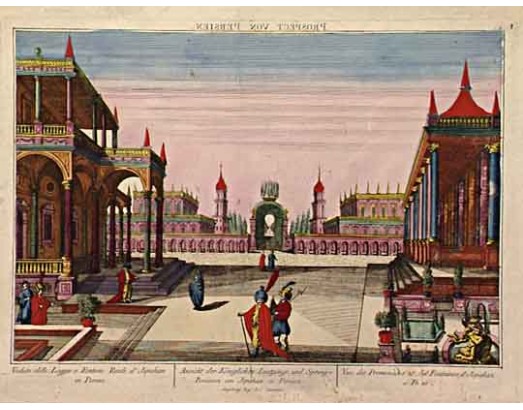CARMINE, I. - Vue des Promenades et les Fontaines d'Ispahan.
 Click on image to zoom
Click on image to zoom

Description
Isfahan was once one of Central Asia's largest and most important cities, at the crossroads of the main north-south and east-west trade routes. The city was the splendid capital of the Seljuq and Safavid dynasties and is renowned for its beauty, which has given rise to the Iranian saying that “Isfahan is half the world.”
Commerce has always been central to the growth of Isfahan, to the extent that the Safavid Shah Abbas I (1588-1629) effectively re-routed the Silk Road through Isfahan and made the city his capital so that his empire would enjoy a trading monopoly. By the seventeenth century, the city attracted not only European merchants but also missionaries and mercenaries, as it became a religiously tolerant center of mercantile and diplomatic activity in which merchants and travelers from various cultures and religions rubbed shoulders.
Isfahan first rose to international prominence as the capital of the great Seljuq Empire (1038-1194), which stretched from Central Asia to Syria. The Seljuqs had a significant impact on the cultural and architectural development of the city, and the consolidation of their empire was also significant in unifying a territory that had been competed for by diverse ethnic groups in central Asia for centuries.
Shah Abbas I, who reigned from 1588 to 1629, made the decision to move the capital from Qazvin to Isfahan in 1590, motivated both by the city's enormous economic potential and position at the crossroads of trade and by concerns for security, given its central location at a safe distance from troubled borderlands. Favorable historical associations also set Isfahan apart from other Iranian cities – as the Seljuq capital, it associated Abbas with an illustrious past dynasty.
The Safavids were a local Iranian dynasty. It was not until the reign of Shah Abbas I that the city was renovated in a style that broke with Seljuq tradition, with the construction of many of the monuments and buildings for which Isfahan is renowned today. Wealth and labor were used to build bridges, roads, and caravanserais to encourage and facilitate trade. The imperial household was transferred there, and followed by merchants and artisans who relocated along with them.
In the eighteenth and nineteenth centuries there were many popular specialty establishments in Paris, Augsburg and London that produced optical viewing devices and special engravings to be viewed through them. I
The viewing devices for which these perspective prints were produced consisted of a lens and a mirror, requiring the use of reversed or mirror-image pictures.
- Reference N°: 02283
